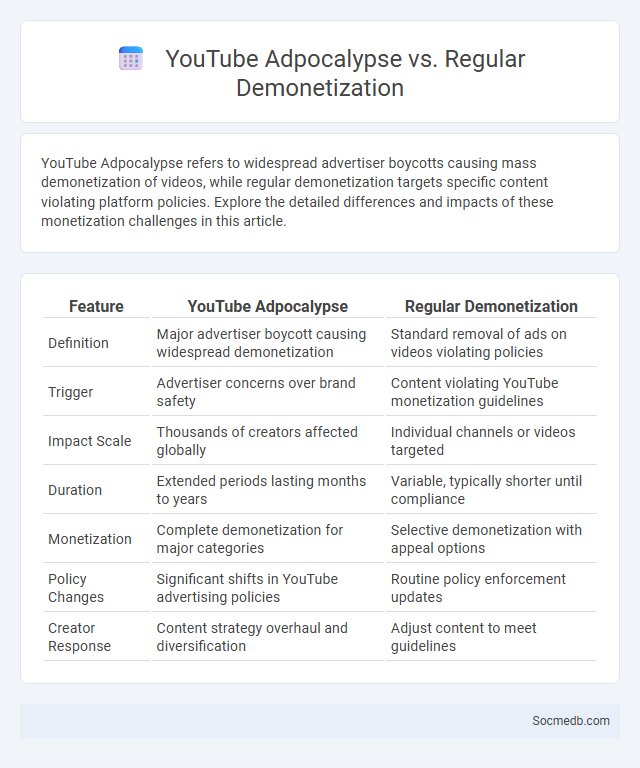
Photo illustration: YouTube Adpocalypse vs Regular Demonetization
YouTube Adpocalypse refers to widespread advertiser boycotts causing mass demonetization of videos, while regular demonetization targets specific content violating platform policies. Explore the detailed differences and impacts of these monetization challenges in this article.
Table of Comparison
| Feature | YouTube Adpocalypse | Regular Demonetization |
|---|---|---|
| Definition | Major advertiser boycott causing widespread demonetization | Standard removal of ads on videos violating policies |
| Trigger | Advertiser concerns over brand safety | Content violating YouTube monetization guidelines |
| Impact Scale | Thousands of creators affected globally | Individual channels or videos targeted |
| Duration | Extended periods lasting months to years | Variable, typically shorter until compliance |
| Monetization | Complete demonetization for major categories | Selective demonetization with appeal options |
| Policy Changes | Significant shifts in YouTube advertising policies | Routine policy enforcement updates |
| Creator Response | Content strategy overhaul and diversification | Adjust content to meet guidelines |
Understanding YouTube Adpocalypse: Definition and Origins
The YouTube Adpocalypse refers to a series of advertiser boycotts and algorithm changes that drastically reduced content monetization starting in 2017. Originating from brand safety concerns after videos containing inappropriate or controversial content gained visibility, major companies pulled ads from YouTube, impacting creators' revenue streams. This event reshaped YouTube's ad policies, content moderation, and monetization criteria to regain advertiser trust and ensure brand-safe environments.
Regular Demonetization: What It Means for Creators
Regular demonetization on social media platforms significantly impacts creators by reducing their revenue streams and limiting content monetization opportunities. You must adapt your content strategies to comply with platform guidelines and diversify income sources to sustain your creative efforts. Understanding these changes is crucial for maintaining financial stability and growth in the digital content landscape.
The Distinction between Demonetization and Demonization
Social media platforms often confuse demonetization and demonization, though they refer to distinct concepts: demonetization involves restricting or removing monetization features from a creator's content, impacting their revenue streams, while demonization is the process of portraying an individual or group as evil or dangerous, fueling negative public perception. Understanding this distinction is crucial for creators navigating platform policies and maintaining their online reputation. Clear differentiation helps users respond appropriately to content moderation actions and social backlash in digital spaces.
Causes and Triggers of the YouTube Adpocalypse
The YouTube Adpocalypse was primarily caused by brand safety concerns, where advertisers pulled their ads due to their placement alongside controversial or inappropriate content. Trigger events included widespread reports of ads appearing on extremist or offensive videos, leading to massive advertiser withdrawals and stricter content policies. Your understanding of these causes highlights the challenges platforms face in balancing content monetization and maintaining advertiser trust.
How Regular Demonetization Impacts Channel Revenue
Regular demonetization on social media platforms significantly reduces consistent revenue streams for content creators by limiting ad placements and sponsorship opportunities. Frequent policy changes and algorithm updates create uncertainty, disrupting income predictability and hindering long-term financial planning for channels. This environment forces creators to diversify income sources beyond ads, such as merchandise or memberships, to maintain financial stability.
Demonization: The Spread of Misinformation and Creator Reputation
Social media platforms contribute significantly to the demonization of individuals by facilitating the rapid spread of misinformation, which often distorts public perception and damages creator reputations. False narratives and manipulated content can quickly go viral, undermining trust and leading to unwarranted backlash against content creators. Algorithms prioritize sensational and controversial material, amplifying harmful misinformation and negatively impacting the social and professional standing of creators.
Comparing Scale: Adpocalypse vs Individual Demonetization Events
The Adpocalypse refers to widespread advertising boycotts that significantly reduced revenue across multiple social media platforms, impacting thousands of creators simultaneously. Individual demonetization events target specific users or content, causing a direct but isolated income loss without affecting the broader community. Understanding the scale difference helps You navigate platform dynamics and diversify revenue streams to mitigate risks.
Algorithmic Changes and Their Effects on Monetization
Algorithmic changes on social media platforms like Facebook, Instagram, and TikTok significantly impact content visibility and user engagement, directly affecting monetization strategies for creators and businesses. Shifts toward prioritizing video content, user-generated posts, and paid promotions alter ad revenue distribution and influencer marketing ROI. Brands must continuously adapt to algorithm updates by optimizing content for platform-specific metrics such as watch time, interaction rate, and relevancy scores to maximize monetization potential.
Creator Responses: Coping Strategies and Advocacy
Creator responses to social media challenges often involve strategic coping mechanisms such as setting boundaries on screen time and engaging in mindfulness practices to mitigate stress. Advocacy efforts focus on promoting platform accountability, improving content moderation policies, and raising awareness about mental health issues within the creator community. Your resilience depends on combining personal well-being techniques with active participation in advocacy for safer digital environments.
The Future of Monetization: Lessons from Past Crises
Social media platforms have adapted revenue models informed by economic downturns and regulatory challenges, prioritizing diversified income streams such as subscription services, e-commerce integration, and creator monetization. These shifts emphasize the importance of resilience and flexibility in You's social media strategy to capitalize on emerging monetization trends. Understanding lessons from past crises enables platforms to innovate while maintaining user engagement and advertiser relationships in fluctuating markets.
 socmedb.com
socmedb.com